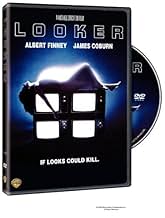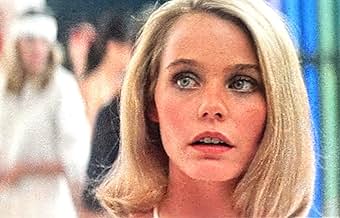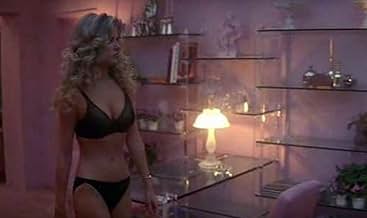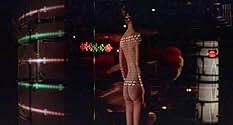VALUTAZIONE IMDb
6,1/10
6587
LA TUA VALUTAZIONE
Tre delle quattro modelle, che hanno subito un intervento di chirurgia plastica da Larry dopo un elenco computerizzato, sono morte.Tre delle quattro modelle, che hanno subito un intervento di chirurgia plastica da Larry dopo un elenco computerizzato, sono morte.Tre delle quattro modelle, che hanno subito un intervento di chirurgia plastica da Larry dopo un elenco computerizzato, sono morte.
- Regia
- Sceneggiatura
- Star
- Premi
- 1 vittoria e 1 candidatura in totale
Michael Hawkins
- Senator Robert Harrison
- (as Michael Gainsborough)
Donna Kei Benz
- Ellen
- (as Donna Benz)
Terrence E. McNally
- Technician in Scanning Room
- (as Terrence McNally)
Recensioni in evidenza
Obviously forgotten today, and maybe that's a problem.
Michael Crichton dealt in practical Science Fiction. How a potential technology could really cause problems in the here and now. This movie hit on a few of them, some of which HAVE come to pass.
His premise is that computers could be used to simulate characters (already has happened) and that they could be used to influence us by using algorithms to calculate our optimum responses. (Again, probably happening now, even if we don't know about it.)
The plot is that a plastic surgeon is asked to alter four women into perfect specimens, but three of them are killed after wards (they never really explain why.) In trying to protect the last, whom he develops a personal bond with, he uncovers a plot to use computer generated images (wow, and now they are real!) to manipulate our responses.
A note on nudity. We have Susan Dey of Partridge family fame going topless in a couple of scenes. We'd NEVER see that now. If we are lucky, we might see a name actress have her head CGI'd (ironic) onto a body double. But usually, the MPAA would go completely nuts and give the film an R or NC-17 rating.
Some things are dated, such as tape-reading computers and big hair on the women- SO 1980's. But the film's concepts hold up pretty well.
Michael Crichton dealt in practical Science Fiction. How a potential technology could really cause problems in the here and now. This movie hit on a few of them, some of which HAVE come to pass.
His premise is that computers could be used to simulate characters (already has happened) and that they could be used to influence us by using algorithms to calculate our optimum responses. (Again, probably happening now, even if we don't know about it.)
The plot is that a plastic surgeon is asked to alter four women into perfect specimens, but three of them are killed after wards (they never really explain why.) In trying to protect the last, whom he develops a personal bond with, he uncovers a plot to use computer generated images (wow, and now they are real!) to manipulate our responses.
A note on nudity. We have Susan Dey of Partridge family fame going topless in a couple of scenes. We'd NEVER see that now. If we are lucky, we might see a name actress have her head CGI'd (ironic) onto a body double. But usually, the MPAA would go completely nuts and give the film an R or NC-17 rating.
Some things are dated, such as tape-reading computers and big hair on the women- SO 1980's. But the film's concepts hold up pretty well.
You can take Michael Crichton's Looker, a way-back-then-high tech thriller with a media-industrial complex, one of two ways. Either it's an interesting preview of computer graphics being used for nefarious advertising gain, with a crime mystery to solve or it's a clumsily acted and directed story of how James Coburn is out to slaughter Albert Finney and Susan Dey using all sorts of out-of-this-world gizmos and tactics.
Personally, I think it's both.
Much like Crichton's Westworld, the movie depends heavily on the computer arts to fill in for substance, and like Westworld, it succeeds. Looker is a pleasant and exciting little period piece, a time capsule for what science and advertising might be heading toward in the not too distant future.
To be fair to yourself, you must forgive the creaky performances by Finney, Dey, and Coburn (plus everyone else). It's the combination of guns, girls, and gadgets that keep the story moving (Crichton gets your attention at the very start by introducing a television lovely asking plastic surgeon Finney to alter her in strangely precise details; then you get the pre-surgery mugshots of the girl with her supposed imperfections--and what imperfections!--in full view). It's cheap and creepy, but everyone in the theater was hooked instantly by the looker on screen.
Don't look too closely, though. The plot holes are big and numerous, so thinking is not recommended. It's the flash-attachments-on-steroids that cause catatonia and the computer mapping of Susan Dey, standing there with her imperfections exposed, that keep you interested. It's strange--I've always liked Dey's looks and I'm not about to complain about seeing her in the all-together, but the bloodlessness of computers, their soul-less nature robs the scene of its prurient nature.
Crichton has hit upon something here. Computers make us so nervous, even a quarter century later, that the use of a story of cynical cyber-manipulation of consumers robs the viewer of getting his or her jollies out of seeing good-looking people nekked or in danger or both. In some ways it robs us of our interest in the human drama that movies depend on to be of lasting quality. It's a double edged sword, but it's both subtle and very effective.
In general, Looker isn't subtle, nor is it a wholly satisfying entertainment, but it does deserve a look.
Personally, I think it's both.
Much like Crichton's Westworld, the movie depends heavily on the computer arts to fill in for substance, and like Westworld, it succeeds. Looker is a pleasant and exciting little period piece, a time capsule for what science and advertising might be heading toward in the not too distant future.
To be fair to yourself, you must forgive the creaky performances by Finney, Dey, and Coburn (plus everyone else). It's the combination of guns, girls, and gadgets that keep the story moving (Crichton gets your attention at the very start by introducing a television lovely asking plastic surgeon Finney to alter her in strangely precise details; then you get the pre-surgery mugshots of the girl with her supposed imperfections--and what imperfections!--in full view). It's cheap and creepy, but everyone in the theater was hooked instantly by the looker on screen.
Don't look too closely, though. The plot holes are big and numerous, so thinking is not recommended. It's the flash-attachments-on-steroids that cause catatonia and the computer mapping of Susan Dey, standing there with her imperfections exposed, that keep you interested. It's strange--I've always liked Dey's looks and I'm not about to complain about seeing her in the all-together, but the bloodlessness of computers, their soul-less nature robs the scene of its prurient nature.
Crichton has hit upon something here. Computers make us so nervous, even a quarter century later, that the use of a story of cynical cyber-manipulation of consumers robs the viewer of getting his or her jollies out of seeing good-looking people nekked or in danger or both. In some ways it robs us of our interest in the human drama that movies depend on to be of lasting quality. It's a double edged sword, but it's both subtle and very effective.
In general, Looker isn't subtle, nor is it a wholly satisfying entertainment, but it does deserve a look.
Plastic surgeon in Los Angeles investigates after some of his most beautiful clients--all fashion models--turn up dead. Thriller has a now-dated design but a terrific set-up. Writer-director Michael Crichton keeps his premise absorbing and exciting for about a third of its length, though he later resorts to assembly-line action, ending the picture on a whimper. Albert Finney just fine in the lead, Susan Dey terrific as his sidekick, yet the characters themselves are rather one-dimensional. Strictly as a time-filler, not bad. **1/2 from ****
Mr. Friedman's review says it all. I loved this film when I first saw it and have never forgotten it. The premise includes the notion that, one day, it will be possible for computers to create lifelike images of real people. 20 yrs. later, we're still working on it, but close. Haven't seen it in a long time but remember it was dramatic and well executed. And yes, I'd personally see this film again just for that scene of Susan Dey's gorgeous bod being turned on a pedestal, being laser scanned into a computer.
I first saw this movie on HBO as a child. I couldn't remember the name of th movie or who played in it, but I couldn't get the scene of Albert Finney on the commercial set near the end of the movie out of my mind. After asking around using that scene as my only guide, I was finally able to get someone to tell me.
After watching it again, I was very interested in the movie's plot despite how ridiculous it seemed. For example, why would RI security officers be at the scene of a car accident? Why didn't DMI use computers to generate locations as well as models? Or why did the mustachioed man suddenly remember he had those special glasses in the car chase scene only AFTER being shot by the LOOKER gun? There are others.
But it has it's redeeming qualities as well. The music is captivating and helps to build on the excitement of some of the action scenes. And I don't believe I've seen a more passionate kick to the groin than the one given by Albert Finney. All in all, Looker would probably not stand up next to today's movies, but it has a charm about it. It must have made some kind of impression on me as a child to remain in my head for the past 25 years. Recommended rental. Buy it if you like off-beat, quasi-mainstream movies. I bought it and plan on getting good use out of it. Perfect for unsuspecting house guests.
After watching it again, I was very interested in the movie's plot despite how ridiculous it seemed. For example, why would RI security officers be at the scene of a car accident? Why didn't DMI use computers to generate locations as well as models? Or why did the mustachioed man suddenly remember he had those special glasses in the car chase scene only AFTER being shot by the LOOKER gun? There are others.
But it has it's redeeming qualities as well. The music is captivating and helps to build on the excitement of some of the action scenes. And I don't believe I've seen a more passionate kick to the groin than the one given by Albert Finney. All in all, Looker would probably not stand up next to today's movies, but it has a charm about it. It must have made some kind of impression on me as a child to remain in my head for the past 25 years. Recommended rental. Buy it if you like off-beat, quasi-mainstream movies. I bought it and plan on getting good use out of it. Perfect for unsuspecting house guests.
Lo sapevi?
- QuizThe first ever film to create 3D shading with a computer that produced the first ever CGI human character was the model Cindy (Susan Dey). This movie achieved this feat before Disney's more famous Tron (1982) hit the screens. The Web site Filmsite said of Cindy: "Her digitization was visualized by a computer-generated simulation of her body being scanned--notably the first use of shaded 3D CGI in a feature film. Polygonal models obtained by digitizing a human body were used to render the effects."
- BlooperAt the conference near the end, when Dr. Larry Roberts is disguised as a security guard, during several sequences getting in and out of elevators the wound on the side of his mouth disappears and reappears.
- Citazioni
Cindy Fairmont: Hi. I'm Cindy. I'm the perfect female type: 18 to 25. I'm here to sell for you.
- Versioni alternativeThe broadcast television version contains additional footage, including a scene where Reston (James Coburn) explains to Dr. Roberts (Albert Finney and Cindy ('Susan Dey') why Digital Matrix had the "perfect" models killed.
- ConnessioniFeatured in Overlook Hotel - Stanza 237 (2012)
I più visti
Accedi per valutare e creare un elenco di titoli salvati per ottenere consigli personalizzati
- How long is Looker?Powered by Alexa
Dettagli
- Data di uscita
- Paese di origine
- Lingua
- Celebre anche come
- Looker
- Luoghi delle riprese
- Art Center College of Design, Pasadena, California, Stati Uniti(Interiors and exteriors. As 'Digital Matrix Inc.' headquarters building.)
- Aziende produttrici
- Vedi altri crediti dell’azienda su IMDbPro
Botteghino
- Budget
- 8.000.000 USD (previsto)
- Tempo di esecuzione1 ora 33 minuti
- Colore
- Mix di suoni
- Proporzioni
- 2.39 : 1
Contribuisci a questa pagina
Suggerisci una modifica o aggiungi i contenuti mancanti

Divario superiore
By what name was Troppo belle per vivere (1981) officially released in India in English?
Rispondi
































